1967 in the Vietnam War
At the beginning of 1967 the United States was engaged in a steadily expanding air and ground war in Southeast Asia. Since its inception in February 1965, Operation Rolling Thunder, the bombing campaign against North Vietnam, had escalated in the number and significance of its targets, inflicting major damage on transportation networks industry, and petroleum refining and storage facilities. Yet the campaign showed no signs of achieving either of its stated objectives. The air attacks had not broken the Hanoi government’s will to continue the war, and they had not halted or appreciably hindered the flow of People's Army of Vietnam (PAVN) troops and supplies into South Vietnam. North Vietnam had been able to repair damage and develop substitutes for destroyed facilities rapidly enough to counter the incremental escalation of the U.S. air campaign. With Soviet and Chinese assistance, the North Vietnamese had built a large and sophisticated air defense system. Its guns and missiles extracted a toll in pilots and aircraft for every American raid. On the ground in South Vietnam, the U.S. force buildup, begun in late 1965, was approaching completion. More than 380,000 American troops were in the country, alongside over 730,000 Army of the Republic of Vietnam (ARVN) soldiers and some 52,000 soldiers from other allied nations. After a year of base building and intensifying combat, the U.S. commander, General William Westmoreland, believed that his forces were ready for major offensives that would seize the battlefield initiative from the PAVN and Viet Cong (VC). The PAVN/VC, however, had been conducting their own buildup, including the infiltration into South Vietnam of regular PAVN divisions. These units, along with VC guerrillas and light infantry formations, were countering the American challenge. Within South Vietnam, the PAVN/VC sought opportunities to inflict American casualties in large and small engagements. They also concentrated troops at various points on South Vietnam’s borders to create a strategic threat to the allies and compel the Military Assistance Command, Vietnam, (MACV) to disperse its reserves.[3]
| 1967 in the Vietnam War | |||
|---|---|---|---|
 Air drop of supplies in Operation Junction City | |||
| |||
| Belligerents | |||
|
Anti-Communist forces: |
Communist forces: | ||
| Strength | |||
|
South Vietnam: 798,800 |
US estimate: 242,000–600,000 | ||
| Casualties and losses | |||
|
US: 11,153 killed South Vietnam: 12,716 killed[1]:275 Allies: Unknown | US estimate: 140,000 casualties[2] | ||
January
2 January
Operation Bolo was a successful combat ruse by the United States Air Force (USAF) that resulted in the USAF shooting down seven Vietnam People's Air Force (VPAF) MiG-21 interceptors.
North Vietnam's Prime Minister Pham Van Dong signaled in an interview with The New York Times correspondent Harrison Salisbury that his nation would begin direct peace talks with the United States if the U.S. maintained an unconditional halt to American bombing, a statement confirmed by President Ho Chi Minh two weeks later.[4]
6 January
In the Third Battle of Nakhang Royal Lao Army (RLA) forces with U.S. air support repulsed a PAVN attack on Lima Site 36 at Na Khang. The PAVN lost an estimated 250 killed and the RLA lost nine killed.[5]:168
6–15 January
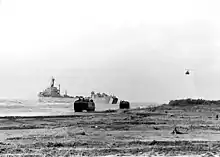
Operation Deckhouse Five was conducted by the United States Marine Corps (USMC) and South Vietnamese Marine Corps forces along the Mekong River Delta. The operation was notable in that it was a sizable, combined USMC and Vietnamese Marine amphibious operation and it was the last Special Landing Force (SLF) amphibious landing to take place beyond the boundaries of I Corps. The operation resulted in 21 VC, seven Marines and one ARVN killed.[6]:151
8–28 January
Operation Cedar Falls was a military operation conducted primarily by U.S. forces. The aim of this massive search and destroy operation was to eradicate the so-called "Iron Triangle", an area located in close proximity to Saigon, which had become a major VC stronghold.[7]:10 The operation resulted in 720 PAVN/VC killed and 218 captured, U.S. losses were 72 killed and ARVN losses were 11 killed.[8]
9 January
In the Raid on Ban Naden a Central Intelligence Agency (CIA)-led team raided a Pathet Lao prisoner of war camp in Ban Naden in northern Laos. The operation successfully freed 82 prisoners.[5]:175–7
The VC sank the dredgeship Jamaica Bay which was dredging for the construction of Đồng Tâm Base Camp, three crewmembers were killed.[9]
10 January
President Johnson delivered the annual State of the Union address to Congress, and told the gathered legislators "I recommend to the Congress a surcharge of 6 percent on both corporate and individual income taxes--to last for 2 years or for so long as the unusual expenditures associated with our efforts in Vietnam continue." Regarding the war, Johnson said "I wish I could report to you that the conflict is almost over. This I cannot do. We face more cost, more loss, and more agony," and he delivered a record 135-billion dollar federal government budget proposal.[10][11]
14 January
A Civilian Irregular Defense Group (CIDG) company engaged a PAVN force near Bù Đốp Camp killing 41 PAVN for the loss of three killed.[12]:113–4
25 January
Lieutenant General Nguyễn Hữu Có was dismissed from his positions as Deputy Premier and Defense Minister of South Vietnam and removed from his place in the military junta governing the nation, by vote of the other junta members.[13]
27 January – 7 April
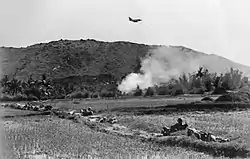
Operation Desoto conducted by the 3rd Battalion, 7th Marines in Đức Phổ District. The operation results in 383 VC and 76 U.S. killed.[6]:63
February
1 February – 18 March
Operation Prairie II was conducted by the 3rd Marine Division to eliminate PAVN forces south of the Demilitarized Zone (DMZ). The operation resulted in 694 PAVN killed and 20 captured and 93 Marines killed.[6]:14
2–21 February
Operation Gadsden was an operation conducted by the 196th Infantry Brigade and the 3rd Brigade, 4th Infantry Division against the PAVN 271st Regiment in Tây Ninh Province. The operation resulted in 160 PAVN and 29 U.S. killed.[14]:114
4 February
The VC attacked the Long Binh Post ammunition supply point, destroying at least 15,000 high explosive 155 mm artillery projectiles.
8 February
President Johnson sent a letter to Ho Chi Minh, by way of Moscow, that began "Dear Mr. President: I am writing to you in the hope that the conflict in Viet Nam can be brought to an end," and outlining his proposal that "I am prepared to order a cessation of bombing against your country... as soon as I am assured that infiltration into South Viet Nam by land and by sea has stopped." Ho would receive the message on February 10 and prepare a response.[15]
12 February – 5 April
Operation Sam Houston was conducted by the 4th Infantry Division in the Plei Trap Valley and Plei Doc. The operation resulted in 733 PAVN and 155 U.S. killed.[16]
12 February – 19 January 1968
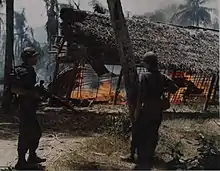
Operation Pershing was an conducted by the 1st Cavalry Division, the 3rd Brigade, 25th Infantry Division, the ARVN 22nd Division and the South Korean Capital Division in Bình Định Province against the PAVN 3rd Division. The operation resulted in 5,401 PAVN killed, 852 U.S. killed and 22 missing and 30+ ARVN killed.[14]:322–4
13 February – 11 March 1968
Operation Enterprise a pacification and security operation was conducted by the 3rd Brigade, 9th Infantry Division and Regional Forces and Popular Forces in Long An Province. The operation results in 241 PAVN/VC killed, 21 captured and 80 defectors. U.S. losses were 31 killed.[17]:118
14 February
The Battle of Tra Binh Dong was probably the most famous battle fought by the Republic of Korea Marine Corps 2nd Marine Brigade. It was fought in the Tra Binh Dong village near the border of Cambodia. The battle resulted in 246 PAVN/VC killed and two captured and 15 Koreans killed.
17–18 February
.jpg.webp)
Operation Bribie, or the Battle of Ap My An, was fought in Phước Tuy Province between the 6th Battalion, Royal Australian Regiment and the VC, reinforced by PAVN regulars.
20 February
The 1st Company of the Third Nung Battalion (Airborne), III Corps' MIKE Force, operating from Bù Đốp Camp engaged a battalion of the PAVN 12th Regiment killing 40 PAVN for the loss of two ARVN.[12]:114–5
21 February
Bernard B. Fall dies after stepping on a landmine while observing a Marine operation on the Street Without Joy in Quảng Trị Province.[18]
22 February – 14 May
Operation Junction City was an 82-day military operation conducted by U.S. and ARVN. It was the largest U.S. airborne operation since Operation Market Garden during World War II, the only major airborne operation of the Vietnam War and one of the largest U.S. operations of the Vietnam War.[7]:10 The operation resulted in 2,728 PAVN/VC and 282 U.S. killed.[19]
March
2 March
Two USAF F-4 Phantoms accidentally bombed Lang Vei in northwest Quảng Trị Province killing at least 100 villagers.[20]
8 March
Secretary of Defense McNamara orders the start of construction of the Strongpoint Obstacle System along the DMZ under the code-name Project Dye-Marker, otherwise known as the McNamara Line.[6]:89
10 March
A U.S. Navy VC-47J crashed near Phan Rang Air Base killing all 25 onboard.[21]
19 March – 19 April
Operation Prairie III was a continuation of Operation Prairie II with essentially the same forces in the same operational area. The operation resulted in 252 PAVN killed and four captured and 56 Marines killed.[6]:19
20 March - 1 April
In Operation Beacon Hill north of Cửa Việt Base Battalion Landing Team 1st Battalion, 4th Marines killed 334 PAVN for the loss of 29 Marines killed.[6]:156
23-4 March
Two CIDG companies engaged a PAVN company 10 km east of Bù Đốp Camp killing 20 with an estimated 40 killed by airstrikes. On 24 March a CIDG company and a MIKE Force company conducted a heliborne assault on the same area and shortly thereafter became heavily engaged with 2 PAVN battalions. Three CIDG were killed and 13 CIDG/MIKE missing while PAVN losses were 98 killed and a further 170 estimated killed by air strikes.[12]:115
April
4 April
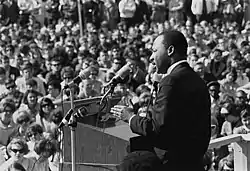
In a speech titled Beyond Vietnam: A Time to Break Silence, his strongest antiwar declaration up to that time, Martin Luther King, Jr. denounced U.S. involvement in Vietnam in a gathering at the Riverside Church in New York City.[22]
6 April
A reinforced PAVN regiment briefly overruns Quảng Trị, freeing 200 PAVN/VC prisoners from a prison before withdrawing from the city.[6]:78
6 April – 11 October
Operation Francis Marion was conducted by the 4th Infantry Division, 173rd Airborne Brigade, ARVN 23rd Division and the 42nd Regiment, 22nd Division in Pleiku, Darlac and the Kon Tum Provinces. The operation resulted in 1,530 PAVN, 300 U.S. and 100 ARVN killed.[14]:309
7–22 April
Operation Lejeune was conducted by the 2nd Brigade, 1st Cavalry Division in Đức Phổ District. The operation resulted in 176 VC killed and 127 captured.[23]:132–4
11 April
Thailand allowed U.S. B-52 bombers to begin flying bombing missions over Vietnam from Thai bases.[24]
15 April
A group of 20 U.S. servicemen marched at the forefront of a parade from New York's Central Park to the United Nations Plaza, behind a banner "Vietnam Veterans Against the War" as part of at least 100,000 protesters in a demonstration organized by the Spring Mobilization Committee to End the War in Vietnam, marking a new development in which American vets would join the anti-war movement. Six of the veterans would form an organization of the same name after the march. What was described as "the largest peace demonstration in decades" in Manhattan lasted for four hours.[25][26]
Forty-one ARVN soldiers were killed and 50 seriously wounded in the Binh Dinh Province when two USAF jets accidentally bombed them.[27]
20 April – 17 May
Operation Prairie IV was conducted by the 3rd Marine Division in the area around Con Thien known as Leatherneck Square.[6]:30
20 April - September 1967
Task Force Oregon is formed from three separate U.S. infantry brigades and an armored cavalry regiment. In September the Task Force was redesignated as the 23rd Infantry Division (Americal).[14]:245
21 April – 16 May
Operation Union was a search and destroy mission in the Que Son Valley carried out by the 1st Marine Regiment to engage the PAVN 2nd Division. The operation resulted in 865 PAVN killed and 110 Marines killed and two missing.[6]:68
22 April – 31 July
Operation Baker was a security operation conducted by the U.S. 3rd Brigade, 25th Infantry Division in the Đức Phổ District. The operation resulted in 1,339 PAVN/VC and 97 U.S. killed.[14]:242
23 April – 7 June
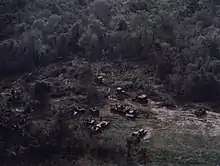
Operation Manhattan was conducted by the 1st and 2nd Brigades, 25th Infantry Division and the 3rd Brigade, 4th Infantry Division in the Ho Bo Woods/Bến Củi area. The operation resulted in 74 VC killed.[14]:146
24 April – 11 May
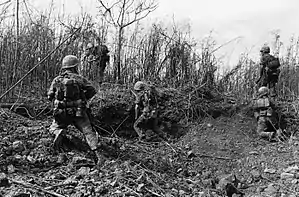
The Hill Fights was a battle between the PAVN and U.S. Marines on Hills 881 North, 881 South and 861 north of Khe Sanh Combat Base. The operation resulted in 940 PAVN and 155 Marines killed.[6]:45
28 April
COMUSMACV General William Westmoreland addressed a joint session of the United States Congress.
World heavyweight boxing champion Muhammad Ali refused to take the oath of induction into the U.S. Army after reporting as scheduled to an induction center in Houston, Texas. Ali was stripped of his boxing title on the same day by the World Boxing Association, and would not be allowed to fight for the title again until 1970.[28] On 20 June Ali would be convicted of draft evasion, fined $10,000 and sentenced to five years in prison, but the conviction would be overturned by the U.S. Supreme Court on 28 June.[29]
28 April – 12 May
Operation Beaver Cage was conducted by the 1st Battalion, 3rd Marines against VC bases in the Que Son Valley. The operation resulted in 181 VC killed and 66 captured and 55 Marines killed.[6]:159
April
Military Assistance Command, Vietnam – Studies and Observations Group commenced Operation Daniel Boone, a cross-border reconnaissance effort in Cambodia.
May
3 May - 19 October
The House Committee on Armed Services established a subcommittee to review the development, history, distribution and adequacy of the M16 rifle after complaints about its reliability in combat, particularly during the Hill Fights. The subcommittee's report found that a change in propellant powder and deficiencies in cleaning were the major causes of problems with the weapon and improved cleaning procedures and the introduction of a chrome-plated chamber on the M16A1 overcame most of the reliability complaints.[30]
4 May
The PAVN attacked Lang Vei Special Forces Camp killing the Special Forces commander and executive officer and 20 CIDG soldiers, while a further 39 went missing; PAVN losses were seven killed.[6]:44
7 May
A VC attack on Binh Thuy Air Base destroyed four RVNAF A-1H Skyraiders and two UH-34s.[31]:56
9 May
Civil Operations and Revolutionary Development Support (CORDS) a U.S. and South Vietnamese pacification program was established under the control of Robert Komer.[32]
11 May – 1 July
Operation Malheur I and Operation Malheur II were a series of military actions conducted by the 1st Brigade, 101st Airborne Division subduing increased activity by VC forces in Quảng Ngãi Province. The operation resulted in 869 PAVN/VC and 81 U.S. killed.[33]
14 May – 7 December
Operation Kole Kole was a search and destroy operation conducted by the 2nd Brigade, 25th Infantry Division in Hậu Nghĩa and Tây Ninh Provinces to engage VC units and interdict infiltration routes. The operation resulted in 797 VC killed and 159 captured and 34 Chieu Hoi and 158 U.S. killed.[34]:3
18–28 May
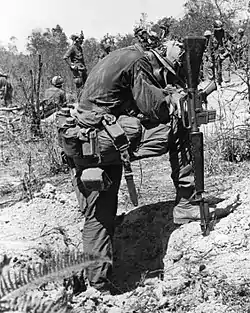
Operation Hickory was a search and destroy operation conducted by the 3rd Marine Division in Leatherneck Square. The operation resulted in 362 PAVN and 142 Marines killed and the removal of the entire civilian population and creation of a free-fire zone.[6]:30
18 May – 7 December
Operation Barking Sands was a pacification operation conducted by the 1st Brigade, 25th Infantry Division in Hậu Nghĩa and Bình Dương Provinces. The operation resulted in 304 VC and 152 U.S. killed.[35]
21 May
The Court-martial of Howard Levy begins at Fort Jackson, South Carolina. Levy, an Army doctor, refused orders to train Green Beret medics on their way to South Vietnam. Levy was convicted and sentenced to three years at Fort Leavenworth.[36]
25 May – 5 June
Operation Union II was a search and destroy mission in the Que Son Valley carried out by the 5th Marine Regiment. The operation resulted in 594 PAVN killed and 23 captured and 110 Marines killed.[6]:74
26 May – 27 January 1968
Operation Dragnet was a security operation conducted by the 1st Cavalry Division in Bình Định Province. The operation resulted in 223 VC and 12 U.S. killed.[14]:322
31 May
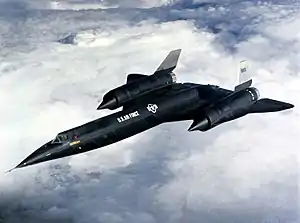
The first USAF Black Shield reconnaissance survey of surface-to-air missile (SAM) sites in North Vietnam by Lockheed A-12 jets took place. The flight took off from Kadena Air Base at Okinawa, refueled then flew over Haiphong, Hanoi and Dien Bien Phu, refueled again over Thailand, then flew over the area above the DMZ, photographing 70 of the 190 known SAM bases.[37]
June
2 June
USAF F-105 jets attacked the North Vietnamese port of Cam Pha and cannon fire struck a Soviet ship, the Turkestan, as it sat in harbor. Nikolai Rybachuk, a Soviet merchant sailor was killed and six others were injured.[38] The United States initially denied that it had struck the Turkestan, but conceded 16 days later that the Soviet ship had been strafed by cannon fire from F-105 jets.[39]
4 June
The Washington Post publishes an article by Ward Just titled "This war may be unwinnable" stating "This war is not being won, and by any reasonable estimate, it is not going to be won in the foreseeable future... It may be unwinnable."[40]
9–29 June
Operation Akron was conducted by the 1st Brigade, 9th Infantry Division, the 1st & 3rd Squadrons, 11th Armored Cavalry Regiment and the ARVN 18th Division in Hát Dịch. The operation resulted in 412 PAVN, 9 U.S. and 51 ARVN killed.[14]:385
12–16 June
Operation Billings was a search and destroy operation conducted by the U.S. 3rd Brigade, 1st Infantry Division north of Phước Vĩnh. The operation resulted in 347 VC killed and one captured and 57 U.S. killed.[14]:343
17 June
United States Secretary of Defense Robert McNamara commissioned the Vietnam Study Task Force, its final report would later become known as the Pentagon Papers.
A USAF C-130B crashed on takeoff from Camp Radcliff killing 35 onboard.[41]
18 June - 2 July
Operation Beacon Torch/Calhoun was conducted by the BLT 2nd Battalion, 3rd Marines southeast of Hội An. The operation resulted in 86 PAVN/VC killed and 13 Marines killed.[6]:162–3
19–21 June
Operation Concordia was an operation conducted by the U.S. Mobile Riverine Force (MRF) in conjunction with ARVN forces. The operation resulted in 255 VC and 46 U.S. killed.[42]:37
20–22 June
The Battle of the Slopes was fought between the 503rd Infantry Regiment and PAVN units on Hill 1388, near Đắk Tô Base Camp in Kon Tum Province. The operation resulted in 79 U.S. and 106–475 PAVN estimated killed.[14]:302
30 June - February 1968
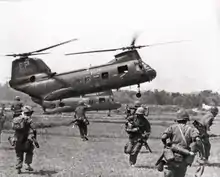
After several accidents and disappearances in the U.S. and South Vietnam all Marine CH-46D Sea Knights were grounded on 30 June, however the CH-46A continued flying. On 31 August a CH-46A on a medical evacuation mission to USS Tripoli disintegrated in midair killing all its occupants. The following day another CH-46A experienced a similar incident at Marble Mountain Air Facility leading to the type being grounded for all except emergency situations and cutting Marine airlift capacity in half.[6]:170 An investigation conducted by a joint Naval Air Systems Command/Boeing Vertol accident investigation team revealed that structural failures were occurring in the area of the rear pylon resulting in the rear rotor tearing off in flight and may have been the cause of several earlier losses. The team recommended structural and systems modifications to reinforce the rear rotor mount as well as installation of an indicator to detect excessive strain on critical parts of the aircraft. The modified CH-46As began returning to service in December 1967 and all had been returned to service by February 1968.[6]:210–1
July
2–14 July
Operation Buffalo was a major operation that took place in the southern half of the DMZ, northeast of Con Thien. On 2 July the PAVN 90th Regiment ambushed the 1st Battalion 9th Marines, the Marines suffered 84 killed, 190 wounded and 9 missing making this the worst one-day loss for the Marines in Vietnam.[6]:103
7 July
Nguyễn Chí Thanh, the commander of Central Office for South Vietnam, dies in Hanoi from a heart attack, wounds suffered in an air raid or poisoning by allies of Võ Nguyên Giáp as part of an internal coup against Thanh's ally, party leader Lê Duẩn.[43][44]:154–5
USAF Major General William J. Crumm, was one six people killed when the B-52 bomber he was on collided with another B-52 over the South China Sea. Crumm was the highest ranking USAF casualty of the war.[45]
9 July
Operation Hong Kil Dong was the largest South Korean operation of the Vietnam War to halt PAVN/VC infiltration near Tuy Hòa. The operation resulted in 638 PAVN/VC killed and 88 captured and 26 Koreans killed.[46]
11 July – 31 October
Operation Diamond Head was conducted by the 3rd Brigade, 25th Infantry Division in Tây Ninh Province. The operation resulted in 136 PAVN and 35 U.S. killed.[14]:385
14 July
In a PAVN rocket attack on Da Nang Air Base over 50 122mm rockets destroyed 10 aircraft, barracks and a bomb dump, damaging a further 40 aircraft and killing 8 Americans and wounding 176.[6]:108–9
16 July – 31 October
Operation Kingfisher was a 3rd Marine Division operation in the western part of Leatherneck Square. The operation resulted in 1,117 PAVN killed and five captured and 340 Marines killed.[6]:139
17 July - mid-December
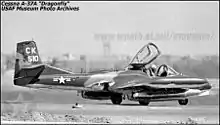
Project Combat Dragon was the combat testing of the A-37A Dragonfly at Bien Hoa Air Base by the 604th Air Commando Squadron.[47]
27–31 July
Operation Coronado II was conducted by the MRF and ARVN units in an attempt to shut down VC strongholds in the Mekong Delta. The operation resulted in 73 VC killed and 68 captured and 9 U.S. killed.[48]:120–4
29 July

A fire on the USS Forrestal operating in the Gulf of Tonkin killed 134 sailors and destroyed 21 aircraft.[49]
29 July - 1 August
In the 1967 Opium War a Shan United Revolutionary Army-led mule train carrying 16 tons of opium crossed into Laos to Ban Khwan, where they were attacked by rival drug smugglers from the Chinese Nationalists' Third and Fifth Armies. The intended recipient of the shipment, Royal Lao Army General Ouane Rattikone, bombed both sides while moving in troops to sweep the battlefield, killing 82 Shan and 70 Nationalists and confiscated the opium for himself.[5]:164–6
late July
In a continuation of the "Revisionist Anti-Party Affair" from January 1964, a series of arrests of "anti-Party" traitors was made in Hanoi. Hoàng Minh Chính and others were accused of plotting against the party and supplying information to an unnamed foreign power, presumably the Soviet Union. A second wave of arrests took place on 18 October and a third wave in December 1967. The arrests effectively removed allies of Võ Nguyên Giáp and opponents to Lê Duẩn's leadership.
August
2–13 August
Operation Hood River was an operation conducted by Task Force Oregon, the South Korean 2nd Marine Brigade and ARVN Ranger Battalions in Quảng Ngãi Province. The operation resulted in 166 PAVN and 21 U.S. killed.[14]:248
3 August
President Johnson asked Congress to temporarily increase individual and corporate income taxes by 10 percent for the 1968 tax year and announced that he had approved sending an additional 45,000 American troops to fight in the Vietnam War before June 30, 1968, bringing the total number of U.S. personnel in South Vietnam to more than half a million.[50]
6 August
The Battle of Suoi Chau Pha was fought between the 7th Battalion, Royal Australian Regiment and the VC 274th Regiment in Hát Dịch. The battle resulted in seven VC killed and a further 33 estimated killed and six Australians killed.[51]
7 August
The New York Times publishes an article by R. W. Apple Jr. titled "Vietnam: the signs of Stalemate." The story quoted one U.S. general (later revealed to be Lieutenant General Frederick Weyand) saying "I've destroyed the [ ] Division three times."[52]
8 August
The Senate Armed Services Committee began hearings on the conduct of the war. Military leaders testified that they were subject to undue restrictions from the civilian leadership, while McNamara testified that the bombing campaign was ineffective.[53]
11 August
The Long Biên Bridge in Hanoi was attacked by U.S. fighter-bombers destroying the center span.[54]
11-27 August
Operation Cochise was conducted by BLT 1/3 Marines 7 miles (11 km) east of Quế Sơn. The operation resulted in 59 PAVN/VC killed and 65 suspects captured, Marine losses were nine killed.[6]:168–9
13–29 August
Operation Benton was conducted by the 1st Brigade, 101st Airborne Division in Quảng Tín Province against PAVN Base Area 117. The operation resulted in 503 PAVN and 45 U.S. killed.[14]:252
19 August – 9 September
Operation Coronado IV was an MRF operation against VC in Long An, Gò Công and Kiến Hòa Provinces. The operation resulted in 59 VC killed.[48]:127
21 August
Two United States Navy A-6A Intruder jets were shot down over the People's Republic of China after straying into Chinese airspace while attempting an attack on North Vietnam. Lieutenant Robert J. Flynn would remain a Chinese prisoner until 15 March 1973.[55]
23 August
VPAF interceptors shoot down three USAF F-4Ds.
30 August
The first six AH-1 Cobras arrive at Bien Hoa Air Base for combat testing by the U.S. Army Cobra New Equipment Training Team.[56]:11
September
3 September
In the 1967 South Vietnamese presidential election, General Nguyễn Văn Thiệu was elected President of South Vietnam, with Air Marshal Nguyen Cao Ky as his running mate.
4 September
An AH-1 Cobra piloted by General George Seneff made the type's first combat kill, sinking a sampan and killing four VC near Muc Hoa.[56]:12
4–15 September

Operation Swift was a search and destroy mission in the Quế Sơn Valley carried out by the 1st Marine Division. Launched on September 4, 1967, the ensuing battles resulted in an estimated 600 PAVN killed and 127 U.S. and 28 ARVN killed.[6]:118–9
5 September – 31 October
Operation Dragon Fire was conducted by the South Korean 2nd Marine Brigade on the Batangan Peninsula. The operation resulted in 541 VC and 46 Koreans killed.[14]:283
11 September
In an interview with U.S. News & World Report U.S. Army Chief of Staff General Harold Keith Johnson stated that "If you exclude the two northernmost provinces of South Vietnam, just south of the Demilitarized Zone, you find that the major forces of the enemy have already been largely broken up... I do not believe that they any longer have the capacity of regular, planned reinforcement."[57]
11 September - October
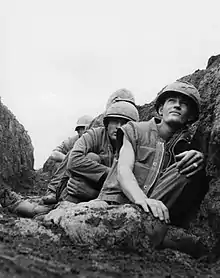
PAVN artillery begins bombarding Con Thien with a peak of 1,200 rounds hitting the base on 25 September.[6]:135–9 CBS News broadcast the first footage of the bombardment on 11 September 1967.[58] TIME featured the story on the cover of its 6 October 1967 issue.[59] David Douglas Duncan's photos of the Marines at Con Thien were featured in the 27 October 1967 issue of Life magazine. CBS News broadcast a special report on 1 October, The Ordeal of Con Thien, hosted by Mike Wallace, which featured footage and interviews from the field.
11 September – 11 November 1968

Operation Wheeler/Wallowa was an operation conducted by the 101st Airborne Division and 1st Cavalry Division and then progressively taken over by 23rd Infantry (Americal) Division in Hiệp Đức District-Quế Sơn Valley. The operation resulted in 3,300 PAVN and 200 U.S. killed.[17]:239
12 September
CIA Director Richard Helms presented President Johnson with a classified report titled "Implications of an Unfavorable Outcome in Vietnam", prepared by analysts in the Office of National Estimates. According to the analysis, "failure would not come as a result of a complete military and political collapse of the U.S. effort in Vietnam, but would evolve from the likely compromise solution that would result from a peace settlement... to the advantage of the Vietnamese Communists". Moreover, the CIA told Johnson, there would be "permanent damage... to the United States in the international arena", internal dissension within the U.S. and destabilization of the other non-Communist nations in Southeast Asia.[60]
The West German hospital ship MV Helgoland moved to Danang from Saigon and would treat civilian patients until 31 December 1971 when it was replaced by a new 170 bed hospital ashore.[61]
12 September – 7 October
Operation Coronado V was an MRF/ARVN operation in Định Tường Province to engage the VC 263rd Main Force Battalion. The operation resulted in 376 VC and 23 U.S. killed.[48]:135
15 September – 10 November
Operation Kunia was conducted by the 1st Brigade, 25th Infantry Division against VC base areas in the Ho Bo Woods. The operation resulted in 105 VC and 40 U.S. killed.[14]:374
19 September
The Royal Thai Volunteer Regiment starts its deployment in South Vietnam.[7]:272
19 September – 31 January 1969
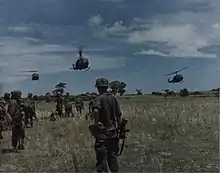
Operation Bolling was a search and destroy and security operation conducted by the 503rd Infantry Regiment in Phú Yên Province. The operation resulted in 683 PAVN killed and 59 captured and 67 U.S. killed.[17]:206
27 September
Canada broke with the United States for the first time over Vietnam War policy, as External Affairs Minister Paul Martin addressed the United Nations General Assembly, suggesting that the U.S. make an unconditional halt to the bombing of North Vietnam. "All attempts to bring about talks between the two sides", Martin said, "are doomed to failure unless the bombing is stopped."[62]
29 September
Speaking in Texas at San Antonio to the National Legislative Conference, President Johnson told his audience, "I am ready to talk tomorrow with Ho Chi Minh and other chiefs of state" to discuss an ending to the Vietnam War, but added that an immediate halt to bombing would happen only if he believed that it would "lead promptly to productive discussion", and that "It is by Hanoi's choice— not ours, not the world's— that war continues." Earlier in the speech, Johnson gave his reasons for a continued fight: "I cannot tell you— with certainty— that a southeast Asia dominated by communist power would bring a third world war closer to terrible reality", he said, "But all that we have learned in this tragic century strongly suggests that it would be so. As the President of the United States, I am not prepared to gamble on the chance that it is not so... I am convinced that by seeing this struggle through now, in Vietnam, we are reducing the chances of a larger war— perhaps a nuclear war."[63] The North Vietnamese government would subsequently reject what would be referred to as "The San Antonio Formula" for peace.[64]
The new U.S. Embassy opened in Saigon.[65]
29 September – 10 December
Operation Shenandoah II was a security operation conducted by the 1st Infantry Division and ARVN forces along Highway 13. The operation resulted in 956 PAVN/VC killed.[17]:67–9
October
3 October
U.S. bombers struck targets in North Vietnam as close as 10 miles (16 km) from China, striking the Loc Dinh highway bridge, the Bao Dang highway bridge 15 miles (24 km) from the frontier and the Ha Thuoc railroad yards, the northernmost penetration into North Vietnam.[66]
6 October

The U.S. Army 334th Assault Helicopter Company became the first operational AH-1 Cobra gunship unit in South Vietnam.[56]:13
8 October
A USAF C-130 crashed into a mountain 24 km south of Phu Bai Combat Base killing all 23 onboard.[67]
10–20 October
Operation Medina was a search and destroy operation conducted by the 3rd Marine Division in the Hải Lăng District. The operation resulted in 53 PAVN killed and three captured and 34 Marines killed.[6]:142
12 October – 31 January 1969
Operation MacArthur conducted by the 4th Infantry Division and 173rd Airborne Brigade in western II Corps. The operation results in 5,731 PAVN/VC and 955 U.S. killed.[68]
16 October
"Stop the Draft Week" was launched in front of Selective Service System induction centers of 30 American cities, by thousands of people protesting against the war. In Oakland, 600 demonstrators blocked the entrance of that city's center, including folk singer and activist Joan Baez, who was one of 125 people arrested. In New York City, 300 demonstrators blocked center entrances. Buses brought protesters to Boston, where 70 draft cards were burned and 200 cards turned over to clergymen of the Unitarian Universalist Church. Similar anti-draft protests took place in Los Angeles; Chicago; Washington, D.C.; San Francisco; Philadelphia; Minneapolis; Portland, Oregon; Albany, New York; and Ithaca, New York; where people either attempted to give their draft cards back to federal authorities, or burned them. According to one account, over 1,000 cards were turned in during the week, and "by the end of the war, 600,000 men had violated the Selective Service laws," with only 3 percent actually prosecuted.[69]
17 October
The Battle of Ong Thanh saw the soldiers of the 2nd Battalion, 28th Infantry Regiment, ambushed by a well-entrenched VC regiment. U.S. losses were 64 killed and 2 missing, VC losses were at least 22 killed.[14]:361
20 October – 16 February 1968
Operation Osceola was a security operation conducted by the 3rd Marine Division around Quảng Trị Combat Base. The operation resulted in 100 PAVN and 19 Marines killed.[70]:135–6

21 October
Approximately 50,000 Americans join the March on the Pentagon and some 650 were arrested.
Life calls for a bombing pause in a shift in editorial policy.[71]:340
24 October
U.S. Army Lieutenant General Lewis B. Hershey, the Director of the Selective Service System, issued the first of two memoranda that would collectively become known as the "Hershey Directive", ordering draft boards nationwide to draft anti-war protesters into the armed services. An injunction against enforcing the directive would be issued by a federal court and the United States Court of Appeals would rule on 6 June 1969, that draft boards had no right to reclassify any registrants based on protest activities.[72]
26 October
U.S. Navy Lieutenant Commander John McCain is captured when his A-4E Skyhawk was shot down on a bombing mission over Hanoi.[73]
27 October
Father Philip Berrigan, a Roman Catholic priest in the St. Peter Claver Church of Baltimore, broke into the city's selective service office and poured blood into 16 file drawers as a protest against the war. Berrigan, who was sent to jail, was joined in the attack by Reverend James Mengel of the United Church of Christ, Thomas Lewis and David Eberhardt of the Baltimore Interfaith Peace organization.[74]
29 October – 7 November
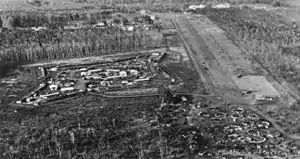
The first battle of Loc Ninh was fought by the VC and the CIDG forces and ended when ARVN and US forces relieved the camp. VC losses were 852 killed and ARVN losses were 50 killed.[75]
November
1 November
U.S. Vice-President Hubert Humphrey presents the Presidential Unit Citation to the 3rd Marine Division and the ARVN 7th Airborne Battalion.[6]:295
1 November – 20 January 1968
Operation Lancaster was a 3rd Marine Division operation to prevent PAVN infiltration from across the DMZ and from the west and to provide artillery and logistical support to the Marines at Khe Sanh. The operation resulted in 46 PAVN and 22 Marines killed.[70]:57
1 November – 22 January 1968
Operation Coronado IX was an MRF/ARVN operation in the Mekong Delta. The operation resulted in 434 VC and 76 U.S. killed.[17]:141
1 November – 25 January 1968
Operation Neosho was a 3rd Marine Division security operation in northern Thừa Thiên Province. The operation resulted in 77 PAVN killed and 9 captured and 12 Marines killed.[70]:82
1 November – 28 February 1969
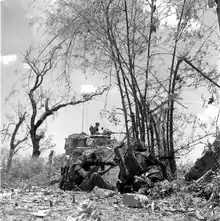
Operation Kentucky was a 3rd Marine Division operation to secure the Con Thien area against PAVN attacks. The operation resulted in 3,839 PAVN killed and 117 captured and 520 Marines killed.[70]:449
2 November
President Johnson held a secret meeting at the White House with a group of "former officials whose advice he trusted" and asked them to suggest ways to unite the American people behind the war effort. The panel, referred to in later histories as "the Wise Men", included Dean Acheson, McGeorge Bundy, Clark Clifford, Henry Cabot Lodge and Maxwell Taylor, who urged the President to continue the war effort and to give the American people more optimistic reports on the war's progress, based on their conclusion that the U.S. was winning the war effort.[76]
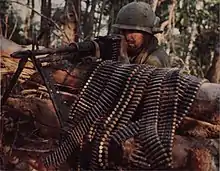
3–22 November
The Battle of Đắk Tô was a series of major engagements that took place in Kon Tum Province. U.S. losses were 361 killed and 15 missing, ARVN losses were 73 killed and 18 missing and PAVN losses were estimated at 1,000–1,664.
3 November – 5 January 1968
Operation Santa Fe was a security operation conducted by the U.S. 1st Brigade, 9th Infantry Division, the 1st Australian Task Force and the ARVN 18th Division against the May Tao Secret Zone. The operation resulted in 126 VC and six U.S. killed.[17]:110
6–17 November
Operation Essex was conducted by the 2nd Battalion, 5th Marines in "Antenna Valley", Hiệp Đức District to push PAVN/VC units into U.S. Army units conducting Operation Wheeler/Wallowa. the operation resulted in 60+ PAVN and 16 Marines killed.[6]:122
7 November
First Sergeant Pascal Poolaw, a Kiowa serving with C Company 26th Infantry Regiment, the most decorated Native American soldier in the U.S. Army, was killed while attempting to aid a casualty during the Battle of Loc Ninh.[77]
9 November
Private McKinley Nolan deserted his unit, the 2nd Battalion, 16th Infantry Regiment near Saigon and joined the VC.[78] The search for what happened to him would be the subject of the 2010 documentary film The Disappearance of McKinley Nolan.
11 November
MACV told reporters that the estimated number of PAVN/VC forces in South Vietnam had declined to 242,000 men, following the previous announced assessment of 299,000 and explained that the decrease was due to "heavy casualties and plummeting morale"; in reality, the decrease came because MACV had decided in July that some categories of VC should be dropped from the total estimate, which had been tallied at 299,000 at the beginning of 1967 in order to maintain the public position that PAVN/VC forces were less than 300,000. In 1975, a former CIA employee, Samuel A. Adams, would reveal the falsifying of numbers in testimony before the U.S. House Intelligence Committee. Adams would also reveal that his review of CIA documents indicated that the strength of the enemy had actually been 600,000 during 1967.[79] Although the difficulties in attempting to put together an educated estimate of PAVN/VC strength in South Vietnam was described in a CIA report on the subject as "we lack precise basic data on population size, rates of growth, and age distribution for both North and South Vietnam", "Our data and conclusions are therefore subject to continuing review and revision, especially since capabilities do not remain static."[80]
13 November
The Joint Chiefs of Staff recommended to The White House that no ceasefire be instigated for the Tết holiday period in January 1968 due to "the fraudulent manner in which the enemy has treated past ceasefires."[81]
14 November
3rd Marine Division commander Major General Bruno Hochmuth and five others die in a helicopter crash northwest of Huế.[6]:345–7
15–19 November
Operation Kien Giang 9-1 was an MRF/ARVN operation to sweep VC Base Area 470 in western Dinh Tuong Province. The operation resulted in at least 178 VC killed and 33 captured while U.S./ARVN losses were 26 killed.[17]:135
17 November
Acting on optimistic reports he had been given by General Westmoreland and by U.S. Ambassador to South Vietnam Ellsworth Bunker, President Johnson said at a press conference that his advisers had assured him that the war in Vietnam was going well, in response to a reporter's question, and that it was a different kind of conflict. "We don't march out and have a big battle each day in a guerrilla war. It is a new kind of war for us. So it doesn't move that fast... We are making progress. We are pleased with the results that we are getting. We are inflicting greater losses than we are taking." Johnson received rave reviews from all that saw this press conference, many newspapers calling it "Johnson's new style" while others said this was the "real Johnson" as the President bullishly informed Hanoi that the United States was prepared to protect their ally from invasion from an aggressive neighbor.[82]
18 November
The VC announced its willingness to honor a seven-day ceasefire during the Tết holiday, for a period running from 27 January through 2 February 1968.[83]
USAF Brigadier General Edward B. Burdett dies shortly after capture in North Vietnam having ejected from his F-105 which was hit by a SAM-2 missile.
19 November
President Thiệu wrote to Ho Chi Minh to request secret talks to start a dialogue between the two countries to start the peace process.[84]
21 November
General Westmoreland told the National Press Club in Washington, "I am absolutely certain that whereas in 1965 the enemy was winning, today he is certainly losing... we have reached an important point... when the end begins to come into view", and forecast that a third phase of the war, when the U.S. would turn over control of the war effort to the ARVN, would start at the beginning of 1968.[85]
26 November
A USAF C-47D crashed while making an emergency landing at Tan Son Nhut Air Base killing all 26 onboard.[86]
27 November
The Joint Chiefs of Staff presented Secretary of Defence, McNamara with their proposed plans for the next four months in the war. The recommendations included not agreeing to a truce period during the upcoming Tết celebrations.[87]
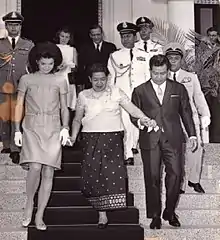
Cambodian Head of State Prince Norodom Sihanouk reacted to U.S. press reports that the VC were using bases in Cambodia as sanctuaries by expelling all foreign journalists from the country.[88]
29 November
Secretary of Defense McNamara announced his resignation and accepted a post as the President of the World Bank.[89]
The VC 3rd Battalion, 272nd Regiment attacked Bù Đốp Camp which was defended by ARVN forces and the U.S. 1st Battalion, 28th Infantry Regiment and Battery A, 2nd Battalion, 33rd Artillery. The VC lost 31 killed in the attack and the U.S. seven killed.[17]:63–5
30 November
U.S. Senator Eugene McCarthy of Minnesota announced his candidacy for the 1968 Democratic Party presidential nomination, in a direct challenge to the renomination of President Johnson. McCarthy said that he would enter the presidential primaries in Wisconsin, Nebraska, Oregon and California, and that he would probably declare for New Hampshire and Massachusetts as well.[90]
A USAF C-7 Caribou crashed into a mountainside while on approach to Qui Nhơn airport, killing all 26 onboard.[91]
November – 9 December 1968

Operation Napoleon/Saline was a 3rd Marine Division, U.S. Army and ARVN 1st Division operation along the Cửa Việt River south of the DMZ. The operation resulted in 3,500+ PAVN and 395 U.S./ARVN killed.[70]:445
December
3 December
The A-7 Corsair II made its combat debut flying from the USS Ranger.[92]
4 December
The U.S. Department of State sent a diplomatic note to Prince Sihanouk, pledging that the U.S. would not cross into Cambodia to pursue PAVN/VC forces fleeing from South Vietnam, and promising to respect "Cambodian neutrality, sovereignty, independence and territorial integrity."[93]
4 December – 17 February 1968
Operation Manchester was a security operation conducted by the U.S. 199th Infantry Brigade in Tân Uyên District. The operation resulted in 456 VC and 37 U.S. killed.[17]:106
5 December

In the Đắk Sơn massacre two VC battalions attacked Đắk Sơn village and killed 114 to 252 Montagnard villagers.
6–20 December
The Battle of Tam Quan was a two-week battle fought when the U.S. 1st Brigade, 1st Cavalry Division and 1st Battalion, 50th Infantry Regiment disrupted the PAVN 22nd Regiment, which was in the process of preparing to conduct a major attack on ARVN installations at Tam Quan.[94] The battle resulted in 650+ PAVN killed and 31 captured and 58 U.S. and 31 ARVN killed.[95]
8 December
ARVN forces trapped two VC battalions in the Mekong Delta at the Kinh O Mon Canal in Chuong Thien Province and killed 365 VC for the loss of 67 ARVN.[96]
The VC 3rd Battalion, 273rd Regiment, attacked of the 1st Battalion, 2nd Infantry Regiment and Battery B, 1st Battalion, 5th Artillery couth of Bo Duc. The attack resulted in 49 VC and four U.S. killed.[17]:63–5
8 December – 24 February 1968
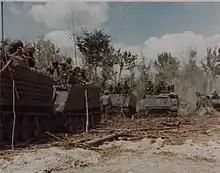
Operation Yellowstone was a security operation conducted by the 1st and 3rd Brigades, 25th Infantry Division in northeast Tây Ninh Province. The operation resulted in 1,254 PAVN/VC and 81 U.S. killed.[97]
8 December – 11 March 1968
Operation Saratoga was a search and destroy operation conducted by the 2nd Brigade, 25th Infantry Division in northeastern Hậu Nghĩa, southern Tây Ninh and western Bình Dương Provinces. The operation resulted in 2,043 PAVN/VC killed and 139 captured and 275 U.S. killed.[98]
15 December
The South Vietnamese government announced that they and their allies would observe a 24-hours stand-down during Christmas Day; this would be followed by second cease-fire between December 31 and January 2. During the 24-hour Christmas ceasefire aerial photographs would later show that 1,300 trucks would be sent from North Vietnam to resupply PAVN/VC forces in the south.[99]
18 December
Operation Eagle Thrust, "the largest and longest military airlift ever attempted into a combat zone", was completed as the last of 10,024 troops from the U.S. Army's 101st Airborne Division arrived at the Bien Hoa Air Base in South Vietnam. Bringing the troops had required 369 C-141 and 22 C-133 aircraft to fly from Fort Campbell, Kentucky.[23]:66
18 December – 10 June 1968
Operation Muscatine was a security operation conducted by the 3rd Brigade, 4th Infantry Division and the 23rd Infantry Division in Quảng Ngãi Province. The operation resulted in 645+ VC killed and seven captured and 25 U.S. killed.[17]:611
21 December
President Johnson, attending memorial services for Australian Prime Minister Harold Holt in Canberra, warned the Australian cabinet that "kamikaze" attacks were coming in South Vietnam.[71]:341
23 December

President Johnson made an unannounced Christmas visit to American troops in South Vietnam, stopping at the Cam Ranh Base at 08:40 local time on his way back from Australia. Johnson was greeted by General Westmoreland and his deputy, General Creighton W. Abrams and Ambassador Ellsworth Bunker. He then conferred briefly with 30 of Westmoreland's field commanders before addressing 2,450 American troops. In a tour of the base hospital, Johnson shook hands with patients and personally presented Purple Heart medals to some of the wounded, then departed at 10:25.[100]
24–5 December
At 18:00 a 24-hour ceasefire went into effect and the United States halted aerial bombing and other offensive operations. The VC had announced a 72-hour ceasefire starting at 01:00 on 24 December, but U.S. command noted 56 incidents of gunfire in the first 12 hours, with one American soldier wounded near An Khe and seven PAVN/VC killed.[101] After a ceasefire that lasted for most of Christmas Day, U.S. warplanes resumed bombing operations at 18:00 over North Vietnam, as well as on convoys that were moving supplies to the PAVN/VC.[102]
During the bombing halt, a representative of the North Vietnamese Politburo addressed PAVN/VC leadership in Thua Thien Province near Huế about the go-ahead for what would become known as the Tet Offensive.[103]
26 December – 2 January 1968

Operation Badger Tooth was a search and destroy operation conducted by the 3rd Battalion, 1st Marines in the Street Without Joy area of Quảng Trị Province. The operation resulted in 131 PAVN and 48 Marines killed.[6]:179
28 December
Cambodia's Prince Sihanouk gave limited permission for U.S. forces to cross from South Vietnam into Cambodia in order to pursue PAVN/VC.[104]
28 December – 3 January 1968
.jpg.webp)
Operation Auburn was a security operation conducted by the 1st Marine Division on Go Noi Island, Quảng Nam Province. The operation resulted in 37 VC and 23 Marines killed.[70]:97
30 December
North Vietnam's Foreign Minister, Nguyen Duy Trinh, stated that his nation would open peace discussions as soon as the United States halted bombing. President Thieu stated that he “saw no real change” in the North Vietnamese Foreign Minister's formulation for peace, while U.S. Secretary of State Dean Rusk questioned the sincerity of the Hanoi regime, in light of the fact that the North Vietnamese had ordered an offensive for the winter season and had already violated the holiday truces.[105] Former U.S. President Dwight Eisenhower later warned President Johnson that "we must not put ourselves in the position of depending upon belief in what a Communist says."[106]
Year in numbers
| Armed Force | Strength[107] | KIA | Reference | Military costs—1967 | Military costs | Reference | ||
|---|---|---|---|---|---|---|---|---|
| 643,000 | 12,716 | |||||||
| 485,600 | 11,153 | [108] | ||||||
| 47,829 | ||||||||
| 2,205 | ||||||||
| 6,818 | ||||||||
| 2,020 | ||||||||
| 534 | ||||||||
| 278,000[109] | 140,000 (casualties) | US Source Estimate[2] | ||||||
| 170,000[44]:138 |
References
| Wikimedia Commons has media related to Vietnam War in 1967. |
- Clarke, Jeffrey (1988). United States Army in Vietnam: Advice and Support: The Final Years, 1965-1973. Center of Military History, United States Army. ISBN 978-1518612619.
 This article incorporates text from this source, which is in the public domain.
This article incorporates text from this source, which is in the public domain. - Art, Robert; Waltz, Kenneth (2004). The Use of Force: Military Power and International Politics. Rowman & Littlefield. p. 241. ISBN 9780742525573.
- Cosmas, Graham (2009). The Joint Chiefs of Staff and the War in Vietnam, 1960-1968 Part 3 (PDF). Office of Joint History Office of the Chairman of the Joint Chiefs of Staff. p. 1. ISBN 978-1482378696.
 This article incorporates text from this source, which is in the public domain.
This article incorporates text from this source, which is in the public domain. - Robert S. McNamara (2007). "Argument Without End: In Search of Answers to the Vietnam Tragedy". PublicAffairs: 288.
- Conboy, Kenneth; Morrison, James (1996). Shadow War: The CIA's Secret War in Laos. Paladin Press. ISBN 0-87364-825-0.
- Telfer, Gary (1984). U.S. Marines in Vietnam: Fighting the North Vietnamese 1967. History and Museums Division, Headquarters, U.S. Marine Corps. ISBN 978-1494285449.
 This article incorporates text from this source, which is in the public domain.
This article incorporates text from this source, which is in the public domain. - Stanton, Shelby L. (2003). Vietnam Order of Battle. Stackpole Books. ISBN 978-0-8117-0071-9.
- Rogers, Bernard (1974). Vietnam Studies Cedar Falls-Junction City A Turning Point. Department of the Army. p. 75. ISBN 978-1931641890.
- Sherwood, John (2015). War in the Shallows: U.S. Navy and Coastal and Riverine Warfare in Vietnam 1965-8. Naval History and Heritage Command. p. 188. ISBN 9780945274773.
 This article incorporates text from this source, which is in the public domain.
This article incorporates text from this source, which is in the public domain. - "Lyndon asks 6% War Tax — Puts Budget at Record 135 Billions". Chicago Tribune. 11 January 1967. p. 1.
- "Transcript State of the Union Address (January 10, 1967)".
- Kelly, Francis (1973). Vietnam Studies U.S. Army Special Forces 1961-1971 (PDF). Department of the Army. ISBN 978-1944961947.
 This article incorporates text from this source, which is in the public domain.
This article incorporates text from this source, which is in the public domain. - "Ouster Shakes Saigon". Chicago Tribune. 26 January 1967. p. 1.
- MacGarrigle, George (1998). Combat Operations: Taking the Offensive, October 1966 to October 1967. United States Army Center of Military History. ISBN 9780160495403.
 This article incorporates text from this source, which is in the public domain.
This article incorporates text from this source, which is in the public domain. - "Text of Johnson Offer to Ho". Chicago Tribune. 22 March 1967.
- "Combat after action report - Operation Sam Houston" (PDF). Defense Technical Information Center. 16 May 1967. pp. 19–22. Retrieved 1 July 2020.
 This article incorporates text from this source, which is in the public domain.
This article incorporates text from this source, which is in the public domain. - Villard, Erik (2017). United States Army in Vietnam Combat Operations Staying the Course October 1967 to September 1968. Center of Military History United States Army. ISBN 9780160942808.
 This article incorporates text from this source, which is in the public domain.
This article incorporates text from this source, which is in the public domain. - Apple, R.W. (21 February 1967). "Bernard Fall Killed in Vietnam By a Mine while With Marines". The New York Times. pp. 1, 4.
- "Data" (PDF). www.dtic.mil. Retrieved 1 July 2020.
- "American Jets Bombed Village In South Vietnam, U.S. Reports". The New York Times. Associated Press. 6 March 1967. p. 6.
- "Aircraft accident Douglas VC-47J (DC-3)". Aviation Safety Network. Retrieved 20 August 2020.
- "U.S. 'Purveyor of Violence,' King Asserts". Chicago Tribune. 5 April 1967. p. 1A–8.
- Tolson, John (1973). Vietnam Studies: Airmobility 1961–1971. Department of the Army. ISBN 9781494721848.
 This article incorporates text from this source, which is in the public domain.
This article incorporates text from this source, which is in the public domain. - "B-52s in First Viet Raids from Thailand Bases". Chicago Tribune. 12 April 1967. p. 7.
- Kertzer, David (1989). Ritual, Politics and Power. Yale University Press. p. 102. ISBN 978-0300043624.
- Hunt, Andrew (1999). The Turning: A History of Vietnam Veterans Against the War. New York University Press. p. 5. ISBN 978-0814736357.
- "U.S. Jets Miss Target; Bombs Kill 41 S. Viet Troops; 50 Hurt". Chicago Tribune. 15 April 1967. p. 6.
- "Clay Dodges Draft; Stripped of Title". Chicago Tribune. 29 April 1967. p. 2.
- Westheider, James (2007). The Vietnam War. Greenwood Publishing. pp. 41–2. ISBN 978-0313337550.
- "Report of the Special Subcommittee on the M-16 Rifle Program". Committee on Armed Services House of Representatives. 19 October 1967. Retrieved 19 July 2020.
- Ballard, Jack (1982). The United States Air Force in Southeast Asia: Development and Employment of Fixed-Wing Gunships 1962–1972 (PDF). Office of Air Force History. ISBN 9781428993648.
 This article incorporates text from this source, which is in the public domain.
This article incorporates text from this source, which is in the public domain. - Scoville, Thomas (1982). Reorganizing for Pacification Support. United States Army Center of Military History. pp. 60–5. ISBN 978-1517302221.
 This article incorporates text from this source, which is in the public domain.
This article incorporates text from this source, which is in the public domain. - "Combat After Action – Operation Malheur, conducted by 1st Brigade, 101st Airborne Division" (PDF). Department of the Army, Office of the Adjutant General. 3 October 1967. Archived from the original (PDF) on 3 October 2012.
 This article incorporates text from this source, which is in the public domain.
This article incorporates text from this source, which is in the public domain. - "Operational Report – Lessons Learned, Headquarters, 25th Infantry Division, period ending 31 January 1968" (PDF). Headquarters, 25th Infantry Division. 14 February 1968. Retrieved 2 July 2020.
 This article incorporates text from this source, which is in the public domain.
This article incorporates text from this source, which is in the public domain. - "Command History 1967 Volume 3" (PDF). Headquarters United States Military Assistance Command, Vietnam. 16 September 1968. p. 1268. Retrieved 2 July 2020.
 This article incorporates text from this source, which is in the public domain.
This article incorporates text from this source, which is in the public domain. - Homer Bigart (21 May 1967). "Court Martial; Levy Pleads the "Nuremberg Defense" Complexion Changes Defense Strategy Soldier's Rights". The New York Times.
- Crickmore, Paul (2013). Lockheed SR-71 Operations in the Far East. Osprey Publishing. p. 18. ISBN 978-1846033193.
- "Russ: Ship Bombed by U.S.— File Protest of Incident in Viet Port". Chicago Tribune. 3 June 1967. p. 1.
- Foreign Relations of the United States, 1964-1968, Volume V: Vietnam, 1967. Government Printing Office. 2002. pp. 459–61.
- Ward Just (4 June 1967). "This War may be Unwinnable". The Washington Post.
- "Aircraft accident Lockheed C-130B Hercules". Aviation Safety Netweork. Retrieved 20 August 2020.
- "U.S. Naval Forces Vietnam Monthly Historical Supplement June 1967" (PDF). Department of the Navy. 17 September 1967. Retrieved 2 July 2020.
 This article incorporates text from this source, which is in the public domain.
This article incorporates text from this source, which is in the public domain. - Maitland, Terrence; McInerney, Peter (1983). The Vietnam Experience: A Contagion of War. Boston Publishing Company. p. 99. ISBN 0939526050.
- Asselin, Pierre (2018). Vietnam's American War A History. Cambridge University Press. ISBN 978-1107510500.
- "AF General Lost When Jets Crash". Cincinnati Enquirer. 8 July 1967. p. 1.
- "Review of significant events" (PDF). Headquarters United States Military Assistance Command, Vietnam. 20 August 1967. p. 2. Archived from the original (PDF) on 17 October 2017. Retrieved 2 July 2020.
- Schlight, John (1999). The United States Air Force in Southeast Asia: The War in South Vietnam The Years of the Offensive 1965–1968 (PDF). Office of Air Force History. pp. 241–2. ISBN 9780912799513.
 This article incorporates text from this source, which is in the public domain.
This article incorporates text from this source, which is in the public domain. - Fulton, William B. (1985). Riverine Operations 1966–1969. United States Army Center of Military History. ISBN 978-1780392479.
 This article incorporates text from this source, which is in the public domain.
This article incorporates text from this source, which is in the public domain. - Stewart, Henry P. (2004). The Impact of the USS Forrestal's 1967 Fire on United States Navy Shipboard Damage Control (PDF) (Master's thesis). United States Army Command and General Staff College. Retrieved 2 July 2020.
- "Johnson OK's Buildup to 525,000 Men— Hikes Estimate of War Cost". Chicago Tribune. 4 August 1967. p. 1.
- McNeill, Ian; Ekins, Ashley (2003). On the Offensive: The Australian Army and the Vietnam War 1967–1968. The Official History of Australia's Involvement in Southeast Asian Conflicts 1948–1975. Volume Eight. Allen & Unwin. p. 215. ISBN 1-86373-304-3.
- Apple, R. W. Jr. (7 August 1967). "Vietnam: the signs of Stalemate" (PDF). The New York Times.
- Karnow, Stanley (1983). Vietnam A History. Viking. pp. 507–9. ISBN 0140265473.
- "Bombing of the Cau Long Bien Bridge in Hanoi on 11 August and the effect of the closing of the bridge on transportation in Hanoi CIA Intelligence Cable 1 September 1967 Doc No/ESDN: 0000505896" (PDF). Central Intelligence Agency. 1 September 1967. Retrieved 2 September 2020.
- Morgan, Rick (2012). A-6 Intruder Units of the Vietnam War. Osprey Publishing. p. 22. ISBN 978-1849087551.
- Bernstein, Jonathan (2003). US Army AH-1 Cobra Units in Vietnam. Osprey Publishing. ISBN 978-1841766065.
- "End of Vietnam War in sight? Size-up by the Army's Chief of Staff Gen Harold K. Johnson". U.S. News & World Report. 11 September 1967.
- Laurence, John (2002). The Cat from Hue. Public Affairs. p. 466. ISBN 1586481606.
- Time Magazine, 06/10/67
- Foreign Relations of the United States, 1964–1968, Volume V: Vietnam, 1967. Government Printing Office. 2002. p. 777. ISBN 978-0160511509.
- Larsen, Stanley (1975). Vietnam Studies Allied Participation in Vietnam (PDF). Department of the Army. p. 165. ISBN 978-1517627249.
 This article incorporates text from this source, which is in the public domain.
This article incorporates text from this source, which is in the public domain. - "Halt Bombing of North Viet as Peace Step, Canada Urges". Chicago Tribune. 28 September 1967. p. 3.
- "LBJ: Would End Raids — If; Willing to Talk to Ho Immediately, He Says". Chicago Tribune. 30 September 1967. p. 1.
- Ritter, Kurt; Medhurst, Martin (2004). Presidential Speechwriting: From the New Deal to the Reagan Revolution and Beyond. Texas A&M University Press. p. 112.
- "US Embassy Design and Construction" (PDF). American Embassy Saigon, Marines and Civilians. Retrieved February 22, 2015.
- "Yank Flyers Raid Seconds from China". Chicago Tribune. 4 October 1967. p. 2.
- "Aircraft accident Lockheed C-130B Hercules". Aviation Safety Network. Retrieved 20 August 2020.
- "United States Military Assistance Command, Vietnam Command History 1969 Volume III" (PDF). Headquarters United States Military Assistance Command, Vietnam. 30 April 1970. p. L-3. Retrieved 2 July 2020.
 This article incorporates text from this source, which is in the public domain.
This article incorporates text from this source, which is in the public domain. - Wiest, Andrew (2009). New Perspectives on the Vietnam War: Re-examining the Culture and History of a Generation. Routledge. p. 134.
- Shulimson, Jack (1997). U.S. Marines in Vietnam: 1968 The Defining Year. History and Museums Division, Headquarters, U.S. Marine Corps. ISBN 0160491258.
 This article incorporates text from this source, which is in the public domain.
This article incorporates text from this source, which is in the public domain. - Oberdorfer, Don (1971). Tet!: The Turning Point in the Vietnam War. The Johns Hopkins University Press. ISBN 0801867037.
- "Protesting Ruled Out As Reason to Draft". Pittsburgh Post-Gazette. 7 June 1969. p. 1.
- Michael Dobbs (5 October 2008). "In Ordeal as Captive, Character Was Shaped". The Washington Post. Retrieved 21 August 2020.
- "Pour Blood into Files of Draft Board— 4 Protesters Seized; 2 Are Clergymen". Chicago Tribune. 28 October 1967. p. 1.
- Olson, James S. (2008). In Country: The Illustrated Encyclopedia of the Vietnam War. Metro Books. p. 313. ISBN 9781435111844.
- Daniels, Robert (1996). Year of the Heroic Guerrilla: World Revolution and Counterrevolution in 1968. Harvard University Press. p. 39. ISBN 978-0465092864.
- Ward, Geoffrey; Burns, Ken (2017). The Vietnam War An Intimate History. Alfred A. Knopf. p. 244. ISBN 978-0307700254.
- Richard Linnett. "A U.S. Traitor's Odd Twist of Fate". Retrieved 25 November 2020.
- U.S. Intelligence Agencies and Activities: The Performance of the Intelligence Community. Government Printing Office. 1975. p. 684.
- "Capabilities of the Vietnamese Communists for fighting in South Vietnam". United States State Department. 13 November 1967. Retrieved 3 July 2020.
 This article incorporates text from this source, which is in the public domain.
This article incorporates text from this source, which is in the public domain. - "Memorandum From the Assistant Secretary of State for East Asian and Pacific Affairs (Bundy) to Secretary of State Rusk Alternatives for Holiday Bombing Pauses". United States State Department. 13 November 1967. Retrieved 3 July 2020.
 This article incorporates text from this source, which is in the public domain.
This article incorporates text from this source, which is in the public domain. - Berman, Larry (1991). Lyndon Johnson's War: The Road to Stalemate in Vietnam. W. W. Norton & Company. p. 115. ISBN 978-0393307788.
- "Cong Offers 13 Days of Truce". Chicago Tribune. 18 November 1967. p. 1.
- "Telegram From the Department of State to the Embassy in Vietnam". United States State Department. 19 November 1967. Retrieved 3 July 2020.
 This article incorporates text from this source, which is in the public domain.
This article incorporates text from this source, which is in the public domain. - "Westmoreland Sees Beginning of End to Viet Nam Conflict". Chicago Tribune. 22 November 1967. p. 5.
- "Aircraft accident Douglas C-47D (DC-3)". Aviation Safety Network. Retrieved 20 August 2020.
- "Memorandum From the Joint Chiefs of Staff to Secretary of Defense McNamara". United States State Department. 27 November 1967. Retrieved 3 July 2020.
 This article incorporates text from this source, which is in the public domain.
This article incorporates text from this source, which is in the public domain. - "The President's Daily Brief" (PDF). Central Intelligence Agency. 27 November 1967. Retrieved 3 July 2020.
- "Defense Chief to Assume Bank Post in 1968". Chicago Tribune. 30 November 1967. p. 1.
- "McCarthy to Oppose LBJ in Primaries". Chicago Tribune. 1 December 1967. p. 1.
- "Aircraft accident de Havilland Canada C-7B Caribou (DHC-4)". Aviation safety Network. Retrieved 20 August 2020.
- Polmar, Norman; Marolda, Edward (2016). Naval Air War: The Rolling Thunder Campaign. Naval History & Heritage Command. p. 11. ISBN 978-1539775898.
- Poulantzas, Nicholas (2002). The Right of Hot Pursuit in International Law. Martinus Nijhoff. p. 33.
- Chaunac, Jacques François de; Duryea, Lyman C. (2003). The American Cavalry in Vietnam: "First Cav". Turner Publishing Company. p. 198. ISBN 978-1563118906.
- "Combat after action report - Battle of Tam Quan" (PDF). Defense Technical Information Center. 30 December 1967. p. 13. Retrieved 2 July 2020.
- "S. Viets Trap Cong in Delta and Kill 365". Chicago Tribune. 9 December 1967. p. 6.
- "Headquarters MACV Monthly Summary February 1968" (PDF). Headquarters United States Military Assistance Command, Vietnam. 29 April 1968. p. 54. Retrieved 2 July 2020.
 This article incorporates text from this source, which is in the public domain.
This article incorporates text from this source, which is in the public domain. - "Combat operations after action report" (PDF). Headquarters, 2nd Brigade, 25th Infantry Division. 1968. pp. 88–90. Retrieved 2 July 2020.
 This article incorporates text from this source, which is in the public domain.
This article incorporates text from this source, which is in the public domain. - "Vietnam War: After Action Reports; Lessons Learned Documents; Battle Assessments" (BACM Research, 2009) p41
- "LBJ Visits Troops In South Vietnam". Pittsburgh Post-Gazette. 23 December 1967. p. 1.
- "Incidents Mar Viet Cease-Fire; Johnson Restates Quest for Peace". Philadelphia Inquirer. 25 December 1967. p. 1.
- "Truce Over; Yank Planes Hit Convoys". Chicago Tribune. 26 December 1967. p. 3.
- Ford, Ronnie (2012). Tet 1968: Understanding the Surprise. Routledge. p. 121. ISBN 978-0714645872.
- "Sihanouk OKs US Pursuit of Reds Across Cambodian Border". Los Angeles Times. 29 December 1967. p. 1.
- "Editorial Note". United States State Department. 29 December 1967. Retrieved 3 July 2020.
 This article incorporates text from this source, which is in the public domain.
This article incorporates text from this source, which is in the public domain. - "Memorandum for Record". United States State Department. 18 January 1968. Retrieved 3 July 2020.
 This article incorporates text from this source, which is in the public domain.
This article incorporates text from this source, which is in the public domain. - Bonds, Ray (1979). The Vietnam War: The illustrated history of the conflict in Southeast Asia. Salamander Books Limited. p. 174. ISBN 0861011082.
- "Statistical information about casualties of the Vietnam War". National Archives and Records Administration. 2010. Archived from the original on 26 January 2010. Retrieved March 6, 2010.
- Military History Institute of Vietnam (2002). Victory in Vietnam: A History of the People's Army of Vietnam, 1954–1975. trans. Pribbenow, Merle. University of Kansas Press. p. 211. ISBN 0-7006-1175-4.